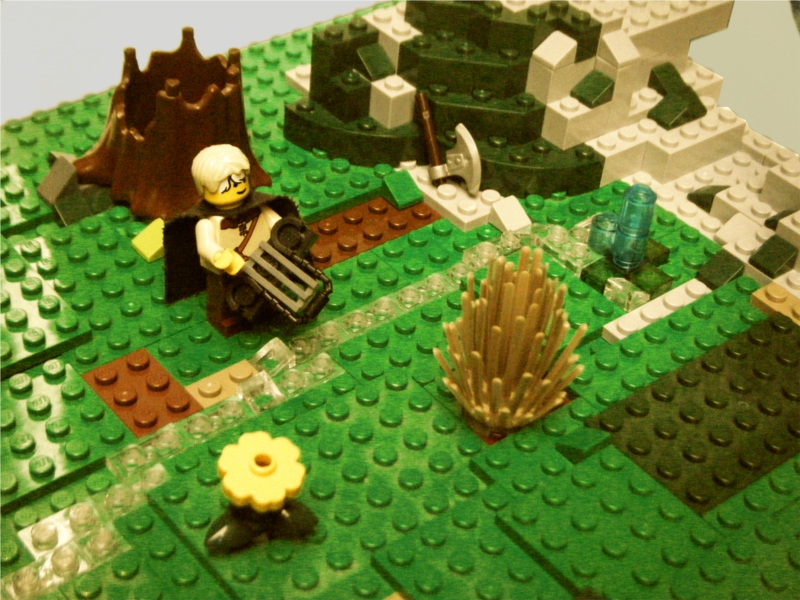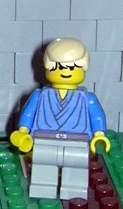At this point, enter the fact that I am a semi-active member at the Barrow-downs, one of the web's best Tolkien-based discussion forums, even if it's a bit sleepy these days. We started a Chapter-by-Chapter discussion of Unfinished Tales. My ambition is thus to make a single LEGO illustration for each of the sections in the book as we read through it. We got through the first two tales before Christmas and should be returning from a holiday hiatus soon.
Thus, to catch myself up, I made a couple MOC-scenes this past week for the first two tales. I say "MOC-scene" because these are not full-fledged, 360 degree angle creations, but MOCs designed for a single illustrative moment. With these illustrations I have the very modest hopes of introducing one or two LEGO fans to the wider world of Middle-earth beyond The Lord of the Rings, and to hopefully help inspire builders (especially builders more talented than myself) to look there for some inspiration too.
Let's begin at the beginning then, by talking about what Unfinished Tales of Númenor and Middle-earth (to use the full title) are all about.
To put things simply, when J.R.R. Tolkien died in 1973, most of what he had written about Middle-earth was incomplete, for which reason it was unpublished. The Hobbit and The Lord of the Rings had been around for four and two decades respectively, but everything else about Middle-earth, which predated both and encompassed a huge mythology, was incomplete.
J.R.R. Tolkien's son, Christopher, who followed in his footsteps as a scholar of Anglo-Saxon, was made his father's literary executor, and out of the mess of papers left behind by Tolkien Sr. was, with the help of Guy Gavriel Kay, able to draw together a single narrative of the main stuff of the mythology: The Silmarillion, published in 1977.
The thing is, though, that this still left many untold stories, some of which simply didn't fit into that part of Middle-earth's history, some of which were simply too incomplete, and some of which were both. Seeing their value as his father's executor and recognising the wide interest readers had shown in the rest of the stuff of Middle-earth, Christopher Tolkien put together Unfinished Tales as a collection of most of the more complete stories that were mostly compatible with the previously works.

The first section of the book is comprised of tales set during the First Age, or the same period of time covered by the the Silmarillion. There are two tales here, and the first of them is "Of Tuor and his Coming to Gondolin."
Actually... the title of the tale was original "Of Tuor and the Fall of Gondolin," but the unfinished nature of tale comes into effect with the fact that Tolkien ceased to work on the story right as Tuor, the main character, reached Gondolin. In a more abbreviated form, the tale of Tuor and Gondolin's fall is one of the constituent tales of the Silmarillion. It is also one of the oldest tales in the mythology, even arguably THE oldest, going back in its original form to Tolkien's time in the trenches of France during World War I.
To put the story as briefly as possible, Tuor son of Huor is a young Man (as opposed to an Elf, Dwarf, or Ork) whose father died during the Nirnaeth Arnoediad, the Battle of Unnumbered Tears, when Morgoth, the Dark Enemy destroyed the good guy armies and took over most of Middle-earth. Tuor has been raised by fugitive Elves, was captured by evil men and made a thrall, and then escaped again. Then comes the scene I have pictured, as Tuor follows his destiny towards the Sea, where he is given a mission: go to the hidden city of Gondolin and convince the Elves there to leave the safety of their secret city, which is nearing the end of its time of safety.
In the picture I've posted, it is spring in the wilds of Hithlum, the northern lands where Tuor's people lived--a cold, cut-off-from-the-sea-by-mountains north country that I imagine to be a lot like the foothills in Alberta. Tuor's heart has been stirred to move after three years on the run, and while he is playing his harp, the spring bubbles over tempestuously. He will then follow the stream and eventually come to the sea, where he will receive his mission.
From a MOCing standpoint, the harp is worth mentioning. I'm not actually sure if I came up with the design myself, as I think I've seen someone else use the http://www.blogger.com/img/blank.giflong-chained cuffs this way before. It was also a complete mess to try and pose, because there's no good way for a LEGO person to hold it.
Tuor himself is based on this picture, from my earlier, illustrate-the-Silmarillion character gallery:

As you can see, he's been updated a little, but still looks essentially the same. Tuor is known to be golden-haired, and because he is mistaken for an Elf a couple times, it seemed fair to make him clean-shaven. I thus stuck with the 1990s Iceplanet/Deputy Sheriff head you see here, but I took advantage of the new male hair in the blond (I got mine with the Series 3 Collectible Minifigs race car driver) to update him a little, and the hardy, former-thrall clothing he wears is right off the peasant from Mill Village Raid.
In the older picture, Tuor has a blue torso, with a custom sticker based on the classic Star Wars Jedi torso. At the time, I was using minifig colour-schemes to show faction allegiances. Blue was used for the House of Fingolfin, one of the royal houses of the High Elves, whose vassals included Tuor's family. Tuor would also go on to serve Fingolfin's son Turgon, when he made it to Gondolin, where Turgon was king. However, since I no longer have the ambitions to illustrate the entire Silmarillion with its gigantic cast of characters, I no longer need to keep all the different factions straight, hence the blander, and more realistic torso.
Tune in soon for Tale II!
No comments:
Post a Comment